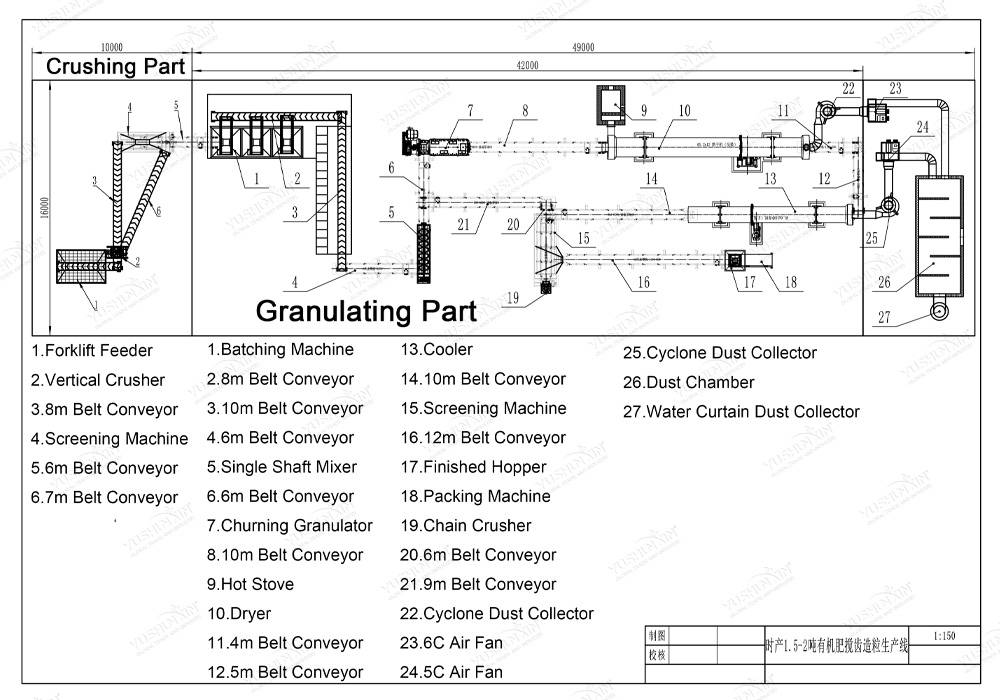







Hogy a foszfÃĄt kÅzetet felhasznÃĄlhatÃģ mÅątrÃĄgya formÃĄvÃĄ alakÃtsÃĄk, sav szÞksÃĐges “szÃĐnsavas” a szikla, amely oldhatÃģ foszforvegyÞleteket bocsÃĄt ki. A felhasznÃĄlt ÃĄltalÃĄnos savak kÃķzÃķtt szerepel:
LÃĐtrehozni NPK mÅątrÃĄgyÃĄk, A nitrogÃĐn ÃĐs a kÃĄlium egyÃĐb forrÃĄsai ÃķsszekeverhetÅk a foszfÃĄt anyaggal. NÃĐhÃĄny pÃĐlda a kÃķzÃĐ tartozik:
Az egyes gyÃĄrtÃģsorok kÃķltsÃĐge a termelÃĐsi kapacitÃĄstÃģl fÞggÅen vÃĄltozik, automatizÃĄlÃĄs foka, ÃĐs speciÃĄlis igÃĐnyek. TÃķltse ki az alÃĄbbi Åąrlapot, ÃĐs pontos ÃĄrajÃĄnlatot adunk Ãnnek!
Ha ÃĐrdekli a mÅątrÃĄgyakÃĐszÃtÅ berendezÃĐsÞnk, KÃĐrjÞk, kÞldje el kÃķvetelmÃĐnyeit ÃĐs kapcsolatait, majd kÃĐt nap mÚlva kapcsolatba lÃĐpÞnk Ãnnel. MegÃgÃĐrjÞk, hogy minden informÃĄciÃģjÃĄt senkinek nem szivÃĄrogtatja ki.
- A tÃĄrsasÃĄgot alapÃtottÃĄk 2005 ÃĐs ÃķsszpontosÃt a szerves mÅątrÃĄgya berendezÃĐsek kutatÃĄsÃĄra ÃĐs fejlesztÃĐsÃĐre ÃĐs gyÃĄrtÃĄsÃĄra 20 ÃĐvek. 40 000 mÃĐteres nagyszabÃĄsÚ organikus mÅątrÃĄgya-gyÃĄrtÃĄsi bÃĄzist ÃĐpÃtett fel, fejlett granulÃĄciÃģval, SzÃĄrÃtÃĄs ÃĐs szÅąrÃĐsi technolÃģgiÃĄk a termelÃĐs hatÃĐkonysÃĄgÃĄnak ÃĐs a termÃĐkminÅsÃĐg javÃtÃĄsÃĄnak javÃtÃĄsa ÃĐrdekÃĐben.
- Egy ÃķnÃĄllÃģ import ÃĐs export vÃĄllalkozÃĄs, tÃķbb mint 80 ProfesszionÃĄlis mÃĐrnÃķkÃķk vilÃĄgszerte, TÃķbbet szolgÃĄlva 100 orszÃĄgok ÃĐs rÃĐgiÃģk szerte a vilÃĄgon, 5,000+ ÞgyfÃĐlszolgÃĄlati esetek, 10 feldolgozÃģ kÃķzpontok, 3 lÃĐzervÃĄgÃģ gÃĐpek, Ãs tÃķbb mint 60 kÞlÃķnfÃĐle tÃpusÚ berendezÃĐsek.
- HosszÚ tÃĄvÚ ÃĐs kiterjedt egyÞttmÅąkÃķdÃĐs fenntartÃĄsa szÃĄmos tudomÃĄnyos kutatÃģintÃĐzettel ÃĐs egyetemmel, with a professional R&D team, folyamatosan optimalizÃĄlhatja a berendezÃĐsek teljesÃtmÃĐnyÃĐt a piaci igÃĐny szerint.
- Nagy szilÃĄrdsÃĄgÚ kopÃĄsÃĄllÃģ anyagok, SzÃĐn acÃĐl Q235/ÃķtvÃķzet kivÃĄlasztva van annak biztosÃtÃĄsa ÃĐrdekÃĐben, hogy a berendezÃĐs tartÃģs legyen ÃĐs csÃķkkentse a karbantartÃĄsi kÃķltsÃĐgeket.
- Intelligens vezÃĐrlÅrendszerek elfogadÃĄsa a termelÃĐsi automatizÃĄlÃĄs szintjÃĐnek javÃtÃĄsa ÃĐs a kÃĐzi fÞggÅsÃĐg csÃķkkentÃĐse ÃĐrdekÃĐben.
- Izo, CE, SGS NemzetkÃķzi TanÚsÃtÃĄs
- NagyszabÃĄsÚ termelÃĐsi kapacitÃĄssal, Ez megfelel a kÞlÃķnbÃķzÅ termelÃĐsi kapacitÃĄsi kÃķvetelmÃĐnyeknek (kicsi, kÃķzepes ÃĐs nagy gyÃĄrtÃģsorok).
- A berendezÃĐsek teljes vÃĄlasztÃĐka, alkalmas kÞlÃķnfÃĐle tÃpusÚ mÅątrÃĄgyÃĄk, pÃĐldÃĄul szerves mÅątrÃĄgya elÅÃĄllÃtÃĄsÃĄra, Ãķsszetett mÅątrÃĄgya, biolÃģgiai mÅątrÃĄgya, vÃzben oldÃģdÃģ mÅątrÃĄgya, folyÃĐkony mÅątrÃĄgya, stb.
- A szemÃĐlyre szabott tervezÃĐs az Þgyfelek igÃĐnyeinek megfelelÅen biztosÃthatÃģ, beleÃĐrtve a termelÃĐsi kapacitÃĄst, helyszÃni elrendezÃĐs, kÃķrnyezetvÃĐdelmi elÅÃrÃĄsok, stb.
- BiztosÃtson egy teljes gyÃĄrtÃģsoros megoldÃĄst, beleÃĐrtve a berendezÃĐsek kivÃĄlasztÃĄsÃĄt, TelepÃtÃĐs ÃĐs Þzembe helyezÃĐs, mÅąszaki kÃĐpzÃĐs, stb.

- KÃķzvetlen gyÃĄri ellÃĄtÃĄs, A kÃķzvetÃtÅ link csÃķkkentÃĐse, Ãs az ÃĄr versenykÃĐpesebb.
- A berendezÃĐs nagy energiahatÃĐkonysÃĄggal rendelkezik, csÃķkkenti az energiafogyasztÃĄst, ÃĐs segÃt az Þgyfeleknek csÃķkkenteni a hosszÚ tÃĄvÚ mÅąkÃķdÃĐsi kÃķltsÃĐgeket.
- KÃķzvetlen gyÃĄri ellÃĄtÃĄs, A kÃķzvetÃtÅ link csÃķkkentÃĐse, Ãs az ÃĄr versenykÃĐpesebb.
- A berendezÃĐs nagy energiahatÃĐkonysÃĄggal rendelkezik, csÃķkkenti az energiafogyasztÃĄst, ÃĐs segÃt az Þgyfeleknek csÃķkkenteni a hosszÚ tÃĄvÚ mÅąkÃķdÃĐsi kÃķltsÃĐgeket.
Supplying a Fertilizer Polishing Machine to a Leading Fertilizer Producer in the Netherlands
Successful Delivery of 1T/H Double-Roller Granulators to Clients in Turkey and the UK
Efficient Compost Turning Solution Delivered to a Philippine Client
Successful Delivery of a Disc Granulator to a Chilean Client for Fertilizer Production
A pelletizÃĄlÃĄs hatÃĐkonysÃĄgÃĄnak nÃķvelÃĐse a GoodEarth Group szÃĄmÃĄra, DÃĐl -Afrika
Az ecuadori Þgyfelek nagyon dicsÃĐrik a szennyvÃz vÃztelenÃtÅgÃĐpet
A vietnami ÞgyfÃĐl magas dicsÃĐrete a kÃĄlium -mÅątrÃĄgya gyÃĄrtÃģsorÃĐrt
A mexikÃģi mÅątrÃĄgya vonalat sikeresen telepÃtettÃĐk
A mÅątrÃĄgya gyÃĄrtÃģ berendezÃĐseinket sikeresen kÃĐzbesÃtettÃĐk AusztrÃĄliÃĄba kÃĄrok nÃĐlkÞl.